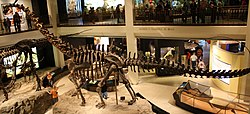Galeamopus
| Galeamopus | |
|---|---|

| |
| Mounted G. hayi holotype skeleton, Houston Museum of Natural Science | |
| Scientific classification | |
| Domain: | Eukaryota |
| Kingdom: | Animalia |
| Phylum: | Chordata |
| Clade: | Dinosauria |
| Clade: | Saurischia |
| Clade: | †Sauropodomorpha |
| Clade: | †Sauropoda |
| Superfamily: | †Diplodocoidea |
| Family: | †Diplodocidae |
| Subfamily: | †Diplodocinae |
| Genus: | †Galeamopus Tschopp et al., 2015 |
| Type species | |
| †Diplodocus hayi Holland, 1924
| |
| Species | |
| |
| Synonyms | |
|
Diplodocus hayi Holland, 1924 (type) | |
Galeamopus is a genus of herbivorous
History

The first specimen referred to Galeamopus was collected by Marshall P. Felch in September, 1884 at his quarry in Garden Park, Colorado. The specimen consisted of a partial skull and mandibles, which Felch sent to his employer at the Yale Peabody Museum, Othniel Charles Marsh, but was later deposited at the National Museum of Natural History (USNM V 2673). It was referred to Diplodocus for many years until Tschopp et al referred the remains to Galeamopus in 2015[1] and Galeamopus pabsti in 2017.[2]
The type specimen of Galeamopus was discovered by fossil hunter William H. Utterback in 1902 near Sheridan, Wyoming, in the Red Fork Powder River Quarry A for the Carnegie Museum of Natural History.[1][3] The specimen was composed of a braincase, partial vertebral column, and several other postcranial elements.[3][1] In 1906, the skeleton was referred to Diplodocus by William Jacob Holland when he described its braincase.[4] The specimen was classified by Holland as a new species of Diplodocus, Diplodocus hayi, in 1924. The specific name honored Oliver Perry Hay.[3]
Another Galeamopus specimen was discovered and collected by Peter Kaisen in 1903 at Bone Cabin Quarry, Wyoming during an American Museum of Natural History expedition.[1][2] This specimen (AMNH 969) consisted of a nearly complete skull and the atlas-axis complex preserved in articulation,[1] and it was also referred to Diplodocus until Tschopp’s reassessment,[2][1] which placed it as a specimen of Galeamopus hayi.[2]
In 2015, it was renamed as the separate genus Galeamopus by
The genoholotype is HMNS 175 (previously CM 662), the original skeleton. It was found in layer of the lower Morrison Formation dating from the Kimmeridgian. This specimen is also the holotype of Galeamopus hayi, the combinatio nova of the type species D. hayi. Several other specimens were referred to the genus Galeamopus but not to Galeamopus hayi.[1] All of the specimens referred to Galeamopus are from the Morrison Formation, with 3 of the 4 specimens collected in Wyoming.[1]
SMA 0011, a skeleton nicknamed "Max" and found in June 1995 at the Howe-Stephens Quarry, was considered sufficiently different from the others to consider naming a separate species for it.
Description
The 2015 study established seven distinguishing traits of the genus as such. These were
The study also determined six autapomorphies of the type species Galeamopus hayi alone. The part of the parietal bone forming the edge between the rear skull and the skull roof is low, with a height less than that of the foramen magnum. The appending basipterygoid processes at the underside of the braincase strongly diverge at an angle of more than 60°. The ulna of the lower arm is long, with a minimum length equalling 76% of the humerus, upper arm bone, length. The surface on the radius contacting the ulna is limited in size and relatively smooth. The joint surface at the underside of the radius is bevelled relative to the shaft, at an angle of about 15°. The outer edge of the top surface of the shinbone forms a pinched process, behind the cnemial crest at the front.[1]
Combined, there are thirteen autapomorphies present in Galeamopus, exactly the minimum the study used as a criterion to distinguish separate genera.[1]
-
G. pabsti skeleton inCincinnati Museum Center at Union Terminal
-
Hypothetical life restoration of G. hayi
Relationships

The cladogram below shows one hypothesis on the relationships of Galeamopus to other diplodocids, as found by the analysis of Tschopp & Mateus (2017).[2]
| Diplodocidae |
| ||||||||||||||||||||||||||||||||||||||||||||||||||||||||||||||||||||||||||||||||||||||||||


